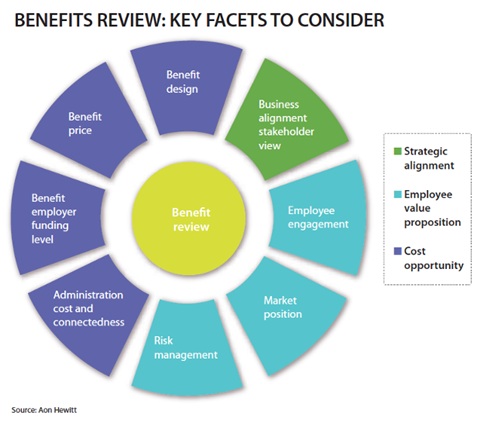If you read nothing else, read this …
- The annual enrolment date can be a good trigger for employers to review and refresh their flex offering.
- A scheme refresh can also be timed for relevant times of the year.
- Changing benefits structures or providers can be a challenge.
Manesh Patel, senior flex consultant at Lorica Consulting, says: “Schemes should be reviewed annually to ensure they stay current and relevant, taking into account market trends, product developments and changes in providers.
“Schemes that are actively changed year-on-year show employees that the [employer] is taking the programme seriously, and that they are always looking to provide their employees with the best in the market.”
Annual refresh
The annual date when employers renew their flexible benefits contracts and rates is an ideal time to refresh their flex scheme design, content and providers.
Graham Jarvis, managing director at Staffcare, says: “This [date] gives an opportunity for an employer to consider whether their objectives in introducing the scheme have been met; to refresh site content, some of which may need to be changed anyway if providers are changing their terms and conditions; to review the benefits they offer, perhaps in the light of take-up, views from staff and benefit costs; and to review the benefit brand and communication materials.”
A long-term plan showing exactly which benefits an employer should offer and when, plus how they should communicate these when setting up a flexible benefits programme, can help organisations plan for a refresh programme, be it a benefits refresh or simply a revamp of their flex communications.
Matthew Gregson, managing consultant at Thomsons Online Benefits, says: “Employers should have a three-year plan to ensure there are new benefits for years two and three. To decide what to do in year one, they should look at what complements existing benefits, and which are likely to have the highest take-up. In future years, [organisations can] potentially survey staff for feedback on what they want.”
Benefits refresh
A structured plan can also help employers to refresh their benefits selection at appropriate times in the year. For example, spring is a good time to introduce bikes-for-work schemes, as staff seek to get fit for the summer. Similarly, access to independent financial advice and debt management specialists is likely to be most appreciated at the start of the year when employees are assessing the impact of their Christmas spending spree.
Employers should be mindful of timing when considering introducing new benefits to their flex scheme. As important as it is for employers to keep pace with market developments, they should avoid overloading their flex plan with an unmanageable number of benefits.
Niall Munro, a director at Fair Care, says: “Employers should consider current usage of the benefits they have. They should not think they have to put hundreds of different benefits online, because staff will get nervous if there is too much choice. There has to be a balance.”
Many of the decisions involved in a flex scheme refresh relate to the scheme’s maturity. Munro says 20 benefits is likely to be too many to offer for some employers, particularly if their flex plan is in its infancy, but this might be a suitable number for more mature schemes.
Kim Honess, head of flexible benefits at Mercer, adds: “If take-up last year was 80% or 90% because the flex plan’s been running for a long time and everyone understands it, then [a refresh] is not absolutely essential, but if it’s newer, then I think it’s always good to do something around communication, even if it’s just little snippets that say ‘here’s an example of what [this employee] did with this benefit last year, and this is how they benefited’.”
Challenges
But Munro says there are challenges for employers when introducing new benefits to a flex plan, such as the time involved. Rate tables, which detail the rates at which an insurer will offer their products and services to an employer, can take as long as four months to produce, he says.
However, new market entrants, particularly online-based insurers, can produce rate tables in just two weeks, says Munro. “Nothing’s complicated to change, but a challenge is that it can take an awfully long time to put [an insurer’s] new rate table into a plan.”
A provider refresh can also present challenges because of the difficulty in transferring staff onto different product structures. For example, it would be difficult to roll an employee with dental insurance that has three levels of cover onto a new scheme with just two levels of cover.
“If the new provider has a different number of levels of cover, an employer can’t roll that [cover] over [from the old provider] because they won’t know which of the new levels an employee is going to want,” says Honess.
The need for employees to educate themselves about new providers and their benefits may also cause a decline in take-up, says Honess. “The risk around changing providers is that employees don’t actually engage and understand, and sometimes they get quite cross,” she says.
“Although there may be better rates and choices and better service going forward [with the new provider], there is bound to be one employee who absolutely loved the old provider.”
Communications strategy
A communications strategy that runs throughout the year, frequently reminding employees about the flex benefits on offer and any changes to the terms and conditions, is one way for employers to keep their plans fresh. It is also a good way to inform employees about any provider changes.
Honess says that although contractual changes must be communicated to staff, it is acceptable for employers to communicate a provider change within their normal flex communications.
But Staffcare’s Jarvis recommends that organisations engage with their employees throughout a refresh process. “This can be done with a subset of the workforce that are representative of all employees’ views, rather than questionnaires to all staff,” he says. “Communicating that [employers] have considered employee views is very powerful when they announce changes.”
That said, Jarvis believes that there is no need for employers to consult employees before making minor changes to their plan, and Lorica’s Patel says there is no hard-and-fast rule on whether employers should communicate a flex benefit plan refresh. “Some [employers] inform employees of change; others include an employee group in the decision process.
“As with most things, everyone will have an opinion and therefore consulting employees in decisions needs to be structured to ensure expectations are managed and an outcome is achieved, and not just a discussion,” he says.
But discussion, particularly about benefit selection, is important, as is communication about the benefits on offer and the way they work. “It may be the case that an organisation needs to spend more money on refreshing how the flex plan is communicated,” says Patel.
Charles Cotton, performance and reward adviser at the Chartered Institute of Personnel and Development, adds: “Employers don’t want to go round introducing complicated benefits unnecessarily.”


Viewpoint: Matthew Gregson
Employers can, in theory, refresh any flexible benefit, but it would not be prudent to change their scheme fundamentally every year.
Organisations should ensure that the big-ticket items they offer employees are right, including holiday, pension scheme and healthcare, and only consider changing these infrequently. It is more appropriate to review add-on benefits, such as dental cover and gyms on a frequent basis.
Employers must be mindful of the fact that changing some benefits may require a change to employees’ terms and conditions, which they may want to avoid.
Again, in theory, anything can change, but that depends on an employer’s legal position and what hoops they would have to jump through to effect the change.
An insurer or benefit provider should always be willing to take on a restructured scheme, but it may place caveats on the range of choice offered each year. For example, employees may be allowed to increase their benefit by only one unit per year.
Insurers are also likely to restrict enrolment opportunities for health and risk benefits in their terms and conditions, but some benefits, such as bikes for work, gyms and childcare, could all have monthly windows, if manageable.
Employees need to be consulted on anything deemed to be a contractual entitlement, which may be trickier to determine than just what’s on a bit of paper.
Ultimately, it is good practice for employers to ensure the flex scheme, range of options and selection of providers remain within the rights of the employer to review, amend and withdraw.
Matthew Gregson is a managing consultant at Thomsons Online Benefits
Read the full Flexible Benefits supplement.























